While enjoying
the sound from newly renovated JBL L26
Decades, I might as well start writing
about the one and only, JBL L100
Century. A month ago one of my friends threw in
these speakers, having bought them from an old
fellow for 300 DKK (50 US $) - a total give-away.
All drivers in mint condition and the cabs with
minor scratches. Tweeter foam had gone but can
easily be replaced from eBay sellers.
I won't go into historical details on the L100 as
so much can be found at:
http://audioheritage.org/html/projectmay/pmintro.htm, and in
particular about the L100 here:
http://audioheritage.org/html/profiles/jbl/l100.htm
A rare opportunity to measure what the L100 did
back then where I could only dream of owing a
pair of these speakers from "over
there". I don't recall the retail price, but
they were very expensive. Having recently
experienced the SEAS 503
kit, I now realise the 503 kit was
actually a better speaker at that time. Quite
similar in size and power handling, the 503 had a
better midrange and a better crossover and the
33FWK bass drivers may beat the 123A drivers. But
the SEAS drivers didn't have the gorgeous looks
of the JBL drivers, the white-coated cone of the
bass driver and the exquisite finish of the LE5-2
driver. I've always had a week spot for the LE5-2
due to how well it is built. Take a look at how
the dust cap is glued to the cone and the fine
touch of paint around the edges. It takes great
skills to make such fine work. However, the LE5-2
is not an easy driver as we shall see later.
This first part
of the my L100 story will not engage in a new
crossover, merely try to find out what the L100
was in terms of driver performance and crossover
construction. And we might as well take a look at
the original crossover right away, because it's
simplicity itself: 8 uF to the mid and 3 uF to
the tweeter. That's all! Both drivers connected
via an L-Pad for attenuation. Mid connected with
inverted polarity. Having a 12" bass driver
running full range is a bold choice and a lot of
work must have gone into designing the 123A
driver to produce a smooth roll off. The LE25 is
a better tweeter than we might think, maybe not
from measuring performance, but well equalised,
it can deliver some excellent treble integrating
well with midrange, actually better than many
modern domes in my opinion. I've recently bought
some LE tweeters on eBay: LE20, LE25 and LE26.
Read here:
http://www.troelsgravesen.dk/JBL_LE20-25.htm
http://www.troelsgravesen.dk/JBL_LE26.htm
|
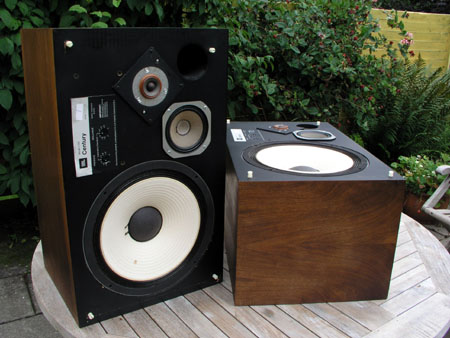 .jpg)
Left: My friend's JBL L100, some scratches to the cabs,
but drivers in mint condition. Right: JBL LE26 tweeter.
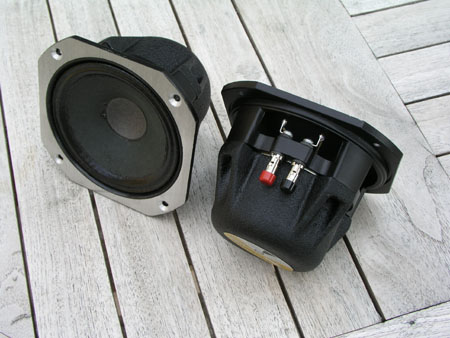 
Here's my own stock drivers for recreating the JBL L100.
I have to say it's much cheaper buying an old pair of
L100s compared to buying the
drivers separately on eBay. On eBay, sellers will
completely strip an L100 speaker and sell it bit by bit
down to the pins holding the front grille.
Useful links (Please
follow all links before e-mailing!):
http://www.troelsgravesen.dk/tips.htm
http://www.troelsgravesen.dk/tips.htm#CONSTRUCTION_OF_CROSSOVERS
http://www.troelsgravesen.dk/crossovers.htm
http://www.troelsgravesen.dk/LCR-RC.htm
http://www.troelsgravesen.dk/Inverted-Polarity.htm
The L100 Cabinet
BACK
TO TOP
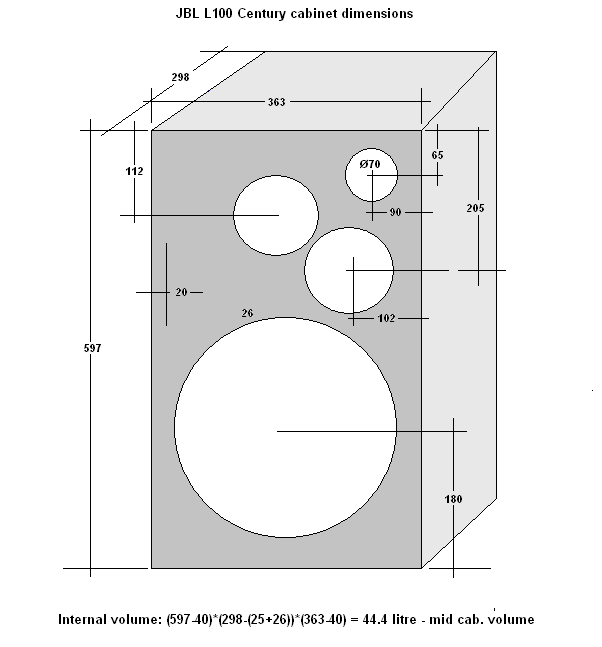
Box simulation
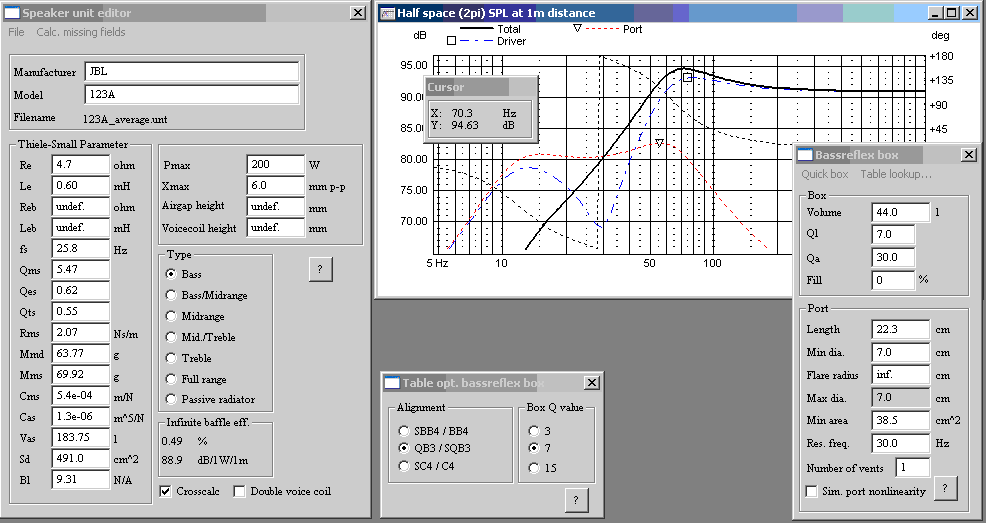
Cabinet
modelling from TS-data reveals the above
seen response profile. Basically the 123A driver
has a too high Qt to be used in a vented cabinet
and the result from a 44 liter volume is a 3-4 dB
increase in response at 70 Hz, which is confirmed
by a nearfield reading of the response.
Place the classic L100 Century on the floor,
close to a wall, and we will have an overall 7 dB
response increase from 50 to 100 Hz. Talk about a
boom box! So, two options available. Add some
acoustic foam to the vent, lift the speaker some
50 cm from the floor, which will raise the bass
driver to ~70 cm from the floor, move it some 100
cm (distance to front panel) out from the rear
wall, place in on the long side of the room with
1.5-2 meters to side walls, and we will reduce
the bass peak to 3 dB above average level. Much
nicer. Placing the L100 in corners is a no-no. |
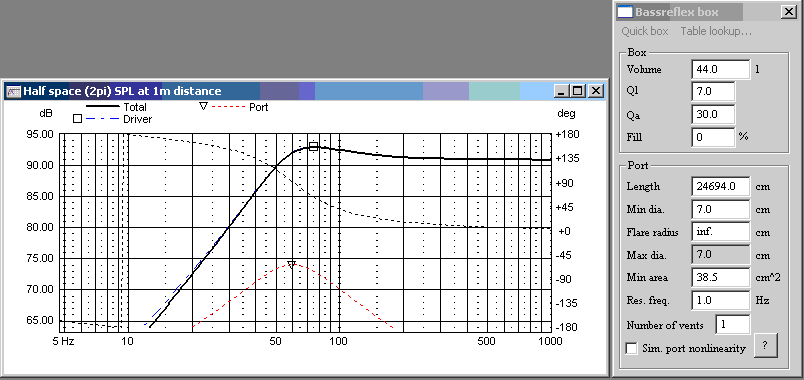
Response in 44 liter closed box (Fb set to 1 = closed
box, for the sake of ease)
Driver performance
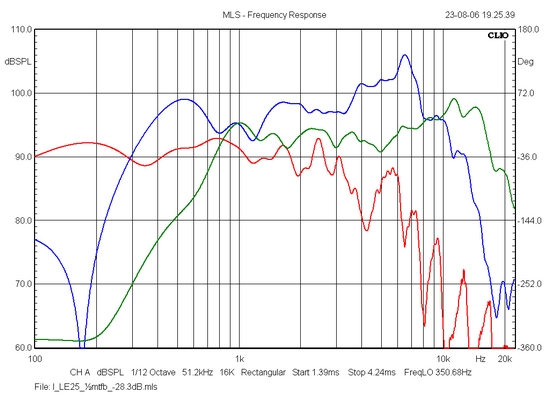 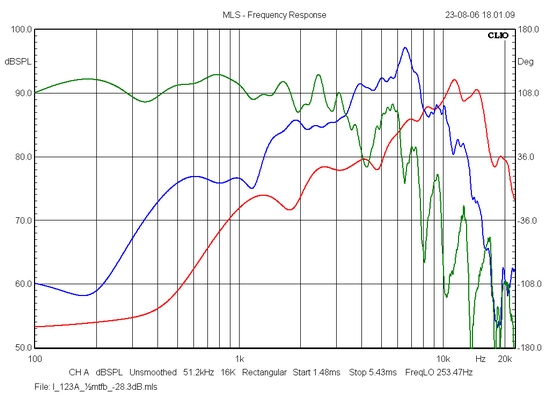
Left: Individual response of drivers
without crossover. Smooth bass roll-off? Well, maybe not
from this cabinet, but take a look below where I compare
the 123A response from the L100 cab and a 60 cm wide,
curved baffle.
The LE5-2 is extremely sensitive. If it hadn't been for
the dip around 1 kHz, we would have had 96-98 dB/2.8V
sensitivity. The peak at 6.5 kHz needs special attention
in the crossover construction.
The LE25 is much better than I had anticipated. It
doesn't matter much whether the foam is in place or not.
It may change the sound, but not measuring performance.
File not shown.
Right: Individual response of drivers from
original crossover with mid and tweeter attenuation set
to zero. Some serious traffic jam around 3-10 kHz - three
drivers all trying to make the most of it here. No wonder
the original set-up fails on vocal recordings.
The 123A bass drivers really shouldn't try to play upper
treble. The mid shouldn't peak at 6.5 kHz and some proper
low-end roll-off might improve performance. And the
tweeter might improve performance from smoothing overall
impedance.
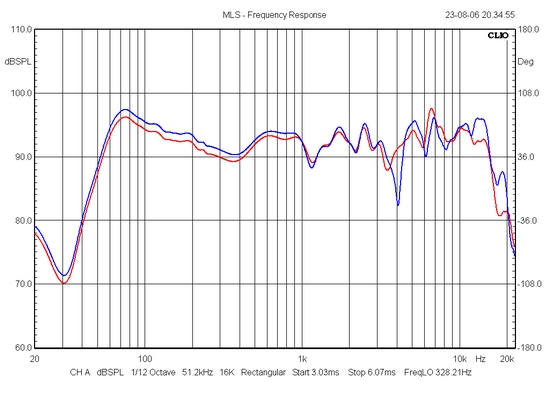
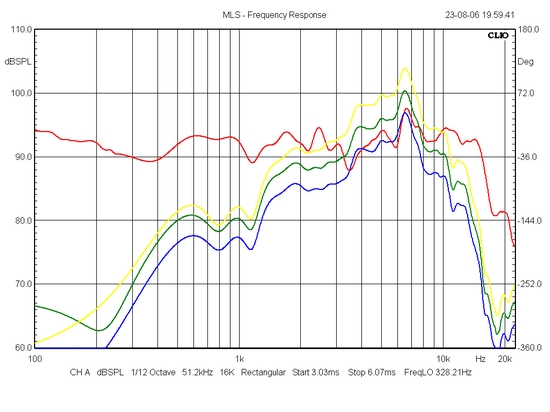
Left: The SPL response of both speakers
with "0" attenuation for the tweeter and -3 dB
attenuation for the mid to get the terrible peak at 6.5
kHz down to reasonable level. I found this attenuation
setting to produce the best overall balanced sound.
Nearfield bass response is merged at 350 Hz. Disregard
difference in bass response. Probably not correct.
Now, listening to some music from this setting may be
close to what we heard back then. Quite an experience to
hear that JBL L100 sound once again. Good? Hmm... Very
impressive, lots of bass, speedy midrange. The sound of
acoustic guitars is very good, but vocals? Something is
very much wrong in the treble area, the 5-10 kHz range I
guess - although I'm strongly biased due to the 6.5 kHz
peak. The danger of knowing what is going on. As soon as
you know how it performs on paper, you can't help
instantly having an opinion about what the sound is like
- and what is wrong about it. But the 6.5 kHz peak is
most likely the cause of some of the problems of this
simplistic crossover set-up. Sibilance is emphasized and
you can't attenuate the mid to get rid of the trouble
without losing tonal balance.
Right: Response of midrange alone with
crossover and attenuation set for -3 dB. Severe dip at
1300 Hz and the 6.5 kHz peak..... This looks like a
poorly managed tweeter response. A response up to 15 kHz!
I mean, a single coil to the mid might at least have
produced a more flat response, but then the upper treble
may run into trouble from this approach.
The Crossover
BACK
TO TOP
Modelling the original crossover
performance
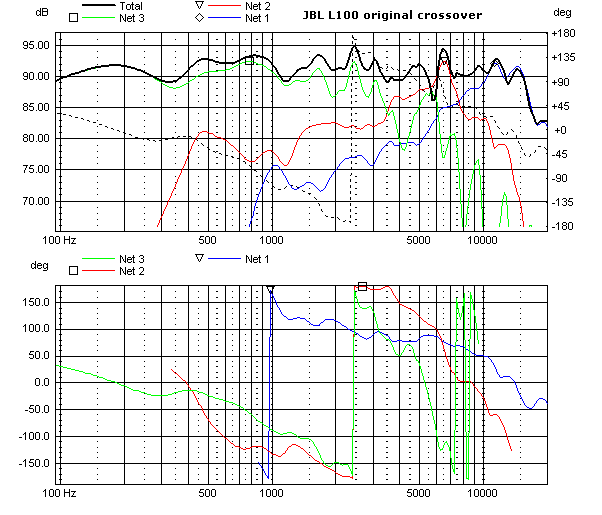
Modelled response of
drivers where the drivers are attenuated with two
resistors in order to recreate the measured
performance. Not that easy, but this is close.
Phase tracking between bass and mid is better
that we might expect, but the tweeter is very
much living its own life in the upper midrange.
When I reverse the polarity of mid and tweeter in
the LspCAD, things at least get worse. It's not that
bad.
|
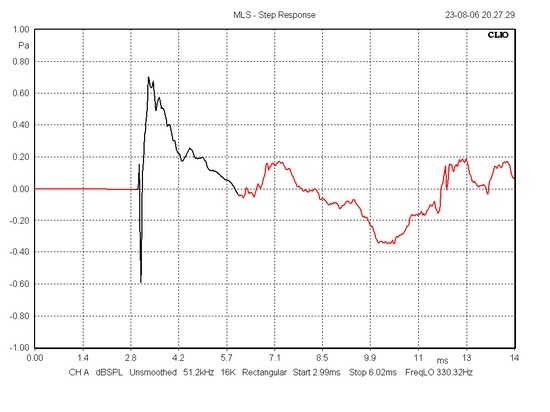
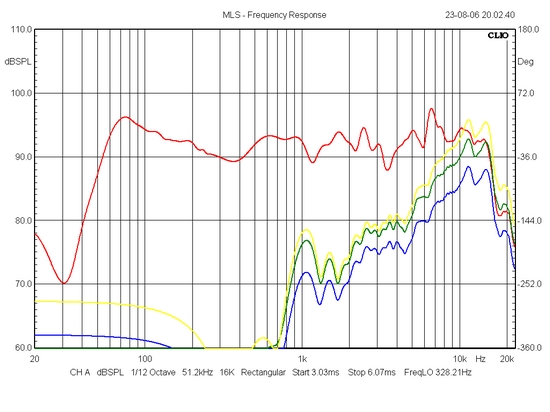
Left: Step response showing reverse mid
polarity. The strange thing about these drivers is that
the red terminal on the 123A bass is correct. The cone
moves out when applied positive voltage. The LE5-2 cone
in moving inwards when positive voltage is applied to the
red terminal. Why would JBL do this? To ensure correct
polarity of drivers when plus wires from crossover were
connected to drivers? But the LE5 was used in other
constructions... Doesn't make sense.
Right: Mid attenuation fixed at -3 dB and
tweeter response shown from +3 dB, 0 dB and -3 dB
settings.
 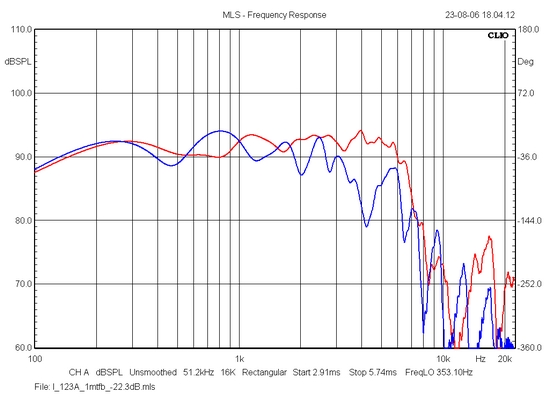
Left: Mid response from attenuation at -3
dB, 0 dB and + 3 dB. Red = summed response from mid
attenuation at -3 dB. If you run the L100 from "mid
+3 dB" it'll rip off your ears!
Right: The 123A bass in L100 cab, blue,
and from a wide curved baffle (red). Now, find a 12"
driver today that will perform flat up to 6 kHz and have
a smooth roll-off. Remarkable!
The LE5-2 middrivers:
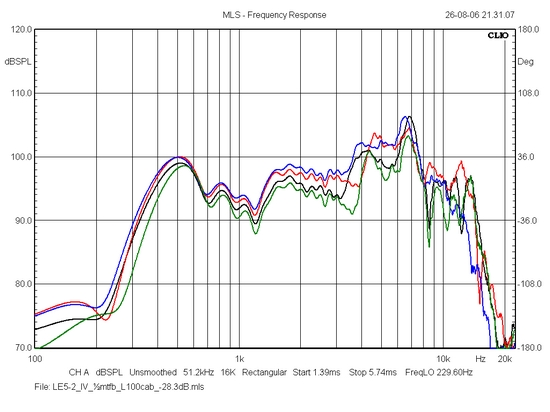
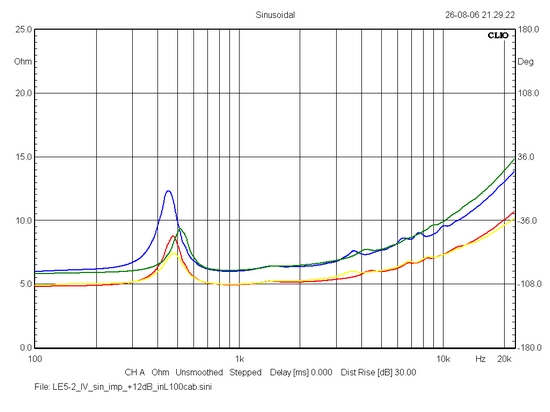
Left: I have two LE5-2 drivers asigned my
future L100 reconstruction. So my friend's L100 gave me
an opportunity to compare four LE5-2 drivers - and there's
some difference! In the upper midrange we have some 4 dB
difference in sensitivity. Basically this is due to
differences in voice coil impedance.
Right: Impedance of four LE5-2 drivers.
From 5 to 7 ohms. Unfortunately both my friend and I have
one of each and the cones are so different in colour that
we can't swap drivers. If you ever buy LE5-2 drivers on
eBay, be sure to have a DCR reading of both drivers
before bidding.
A new crossover designed for all variants of LE5-2
drivers is a challenge and fortunately it can be done due
to the very high sensitivity of the middriver. Placing a
resistor before the driver will increase impedance and
the kit crossover will have a deviation in midrange level
of +/- 1 dB from the shown drivers. This is manageable
and for those who want to do some fine-tuning, the mid
level may be increased or decreased by the input
resistor. Problem solved.
New crossover design
criteria
A lot of work has gone
into designing a new crossover and
numerous simulations and actual crossover
constructions have been tried in order to try
taming the LE5-2 middriver and provide an overall
balanced sound from the L100.
What I wanted was to maintain the basic virtues
of the L100, i.e. the 123A bass driver working -
almost - full range, thus a 1st order filter was
soon in place. To maintain 1st order filtering as
high up in frequency as possible, the LE5-2 had
an LCR circuit to flatten the rise in impedance
at Fs, allowing the high-pass section to be one
single capacitor. To cope with amplitude and
phase between mid and tweeter, the mid needs a
2nd order low-pass section and the LE25 needs a
3rd order filter at 5 kHz to get amplitude and
phase in place. See graphs below.
Three significant things
have happened here: First of all, the LE5-2
middriver no longer peaks at 6.5 kHz. Secondly
the mid-section was constructed in such a way
that the common variation in driver impedance
(LE5-2) only produce minor deviation from target
response. Last but not least, both the tweeter
and mid now produce a smooth roll-off below
points of crossover.
Should you want to increase mid and tweeter
levels, you may bypass R2011 (mid) and increase
R1061 (tweeter) from 4R7 to 5R6. Both 4R7 and 5R6
are supplied with the kit for you to esperiment.
|
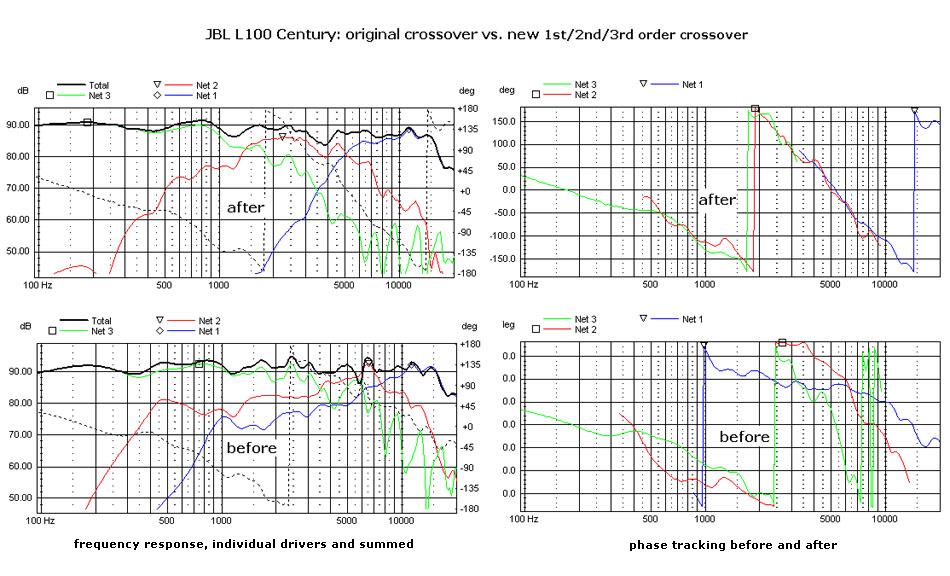
The
New Crossover
BACK
TO TOP
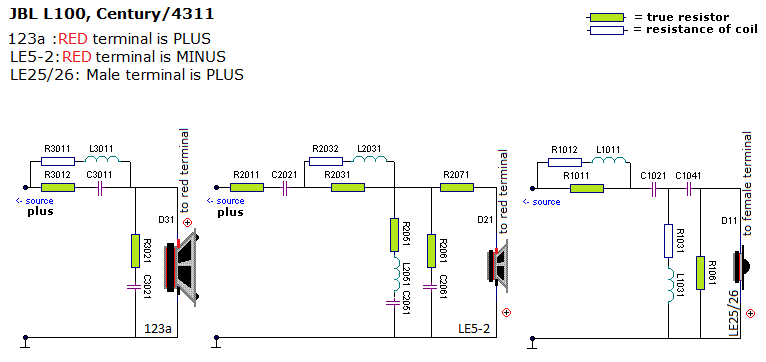
New crossover topology. Pay notice to terminal lay-out of
JBL drivers.
Please note this is a commercial kits. Component values
comes with the instruction manual.
Finding
the polarity of a driver:
Use a 1.5V battery and connect to driver's terminals (only for ~½
second).
When a positive voltage is applied to a terminal and the cone moves
outwards, then you have found the PLUS terminal.
Using attenuators
Attenuators have a
bad reputation, but usually from failing after many years of service.
From my own experiments new attenuators do not degrade the sound as
such. Whether your JBL attenuators need replacing is hard to say, but if
you can turn them fully without pops or cracks, they're probably OK and
you can wire as seen below. For replacements you need to go to eBay and
source similar products. Fostex has some nice products, but not cheap at all.
https://www.ebay.co.uk, and 100 watt is more than enough. 20-50
watts is more than enough.

Above the wiring in case you want to maintain
the attenuators.
I suggest then picking the lowest level of fixed
attenuation for midrange and tweeter, leaving some headroom for both.
For the midrange R2011 is reduced to 1.0 Ohm and for tweeter R1061
increased to 10 Ohm.
Installing the new crossover
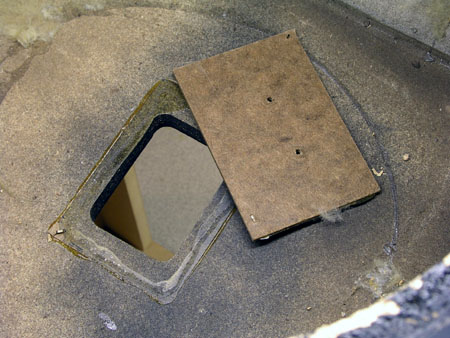 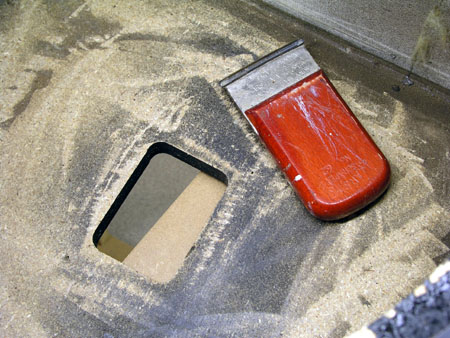
Remove old terminals including the thin masonite panel.
Scrape off residual glue and sand the rear cabinet panel
to make a smooth surface.
http://www.troelsgravesen.dk/tips.htm#CONSTRUCTION_OF_CROSSOVERS

Crossover components for one speaker. Level 4 components shown.
Board
is 180 x 280 mm.
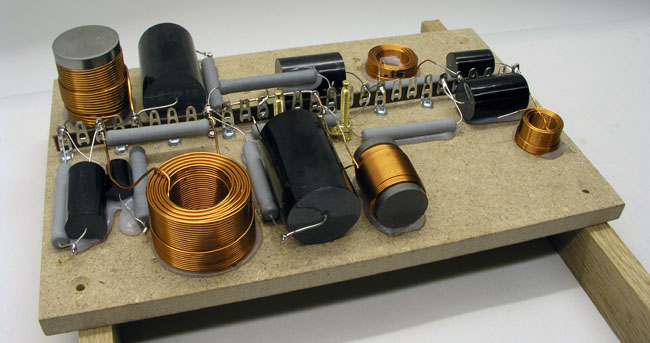
The crossover layout was changed since this early prototype. View
below.
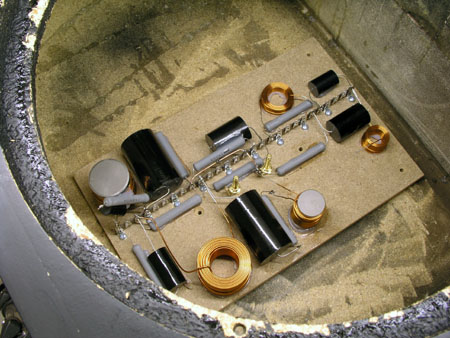 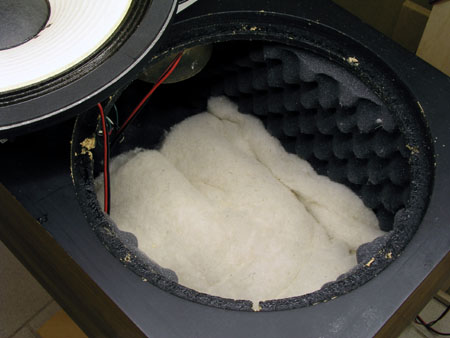
Left: Trying out the crossover/terminal board.
Right: New damping
material and after installing the new crossover, a piece 30 x 60 cm
Acoustilux is folded and placed on top of
crossover.
The Kit
BACK
TO TOP
The complete kit (a pair)
includes:
1. Terminals.
2. Two extra resistors for tweeter attenuation.
3. Solder tag strips.
4. All crossover components: Baked non-resonant
coils, all polypropylene capacitors, MOX/Superes
resistors and cables for connecting drivers.
5. Kit instruction containing crossover
schematics, a short version of this page and
large sharp photos of the assembled crossover
board.
6. Damping materials
The
kit does not come pre-assembled.
Make a crossover board
from e.g. 10-12 mm MDF or plywood, 180 x 290 mm.
The kit price is set at a level where you
cannot buy similar quality components at a lower
price from any supplier.
Please clearly state what
speaker you have and what the drivers are before contacting
Jantzen Audio.
Contact Jantzen Audio incl your zip code for kit price incl. shipping and payment instructions:
contact@jantzen-audio.com
|
The Up-Grade Kit is
available in two quality grades.
To give you an overview of options
available I've made this presentation:
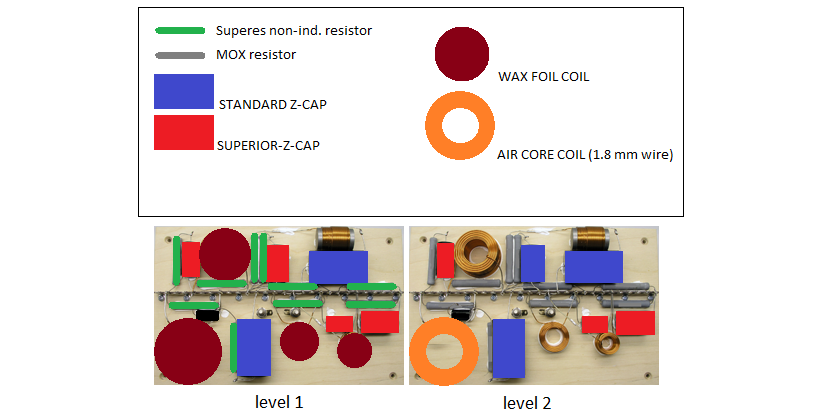
Download Sales Presentations
for Century L100, 4311 and 4310 kits
Contact Jantzen Audio for kit price incl shipping and payment instructions:
contact@jantzen-audio.com
All technical
questions to me at
troels.gravesen@hotmail.com
Crossover
layout
http://www.troelsgravesen.dk/tips.htm#CONSTRUCTION_OF_CROSSOVERS
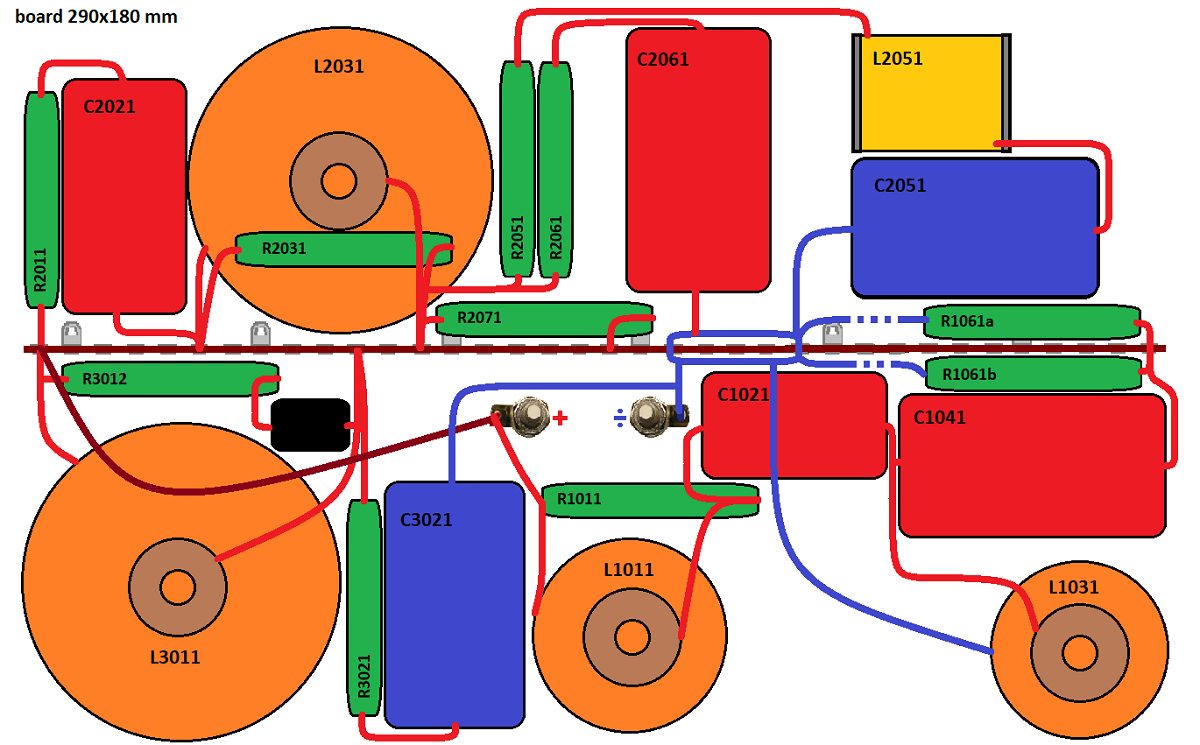
Above the level 1
version. Layout is the same for level 2-3-4, but caps and coils are
smaller.
R1061a and -b is
for tweeter attenuation. Highest value = highest treble level.
Crossover board

Speaker wiring
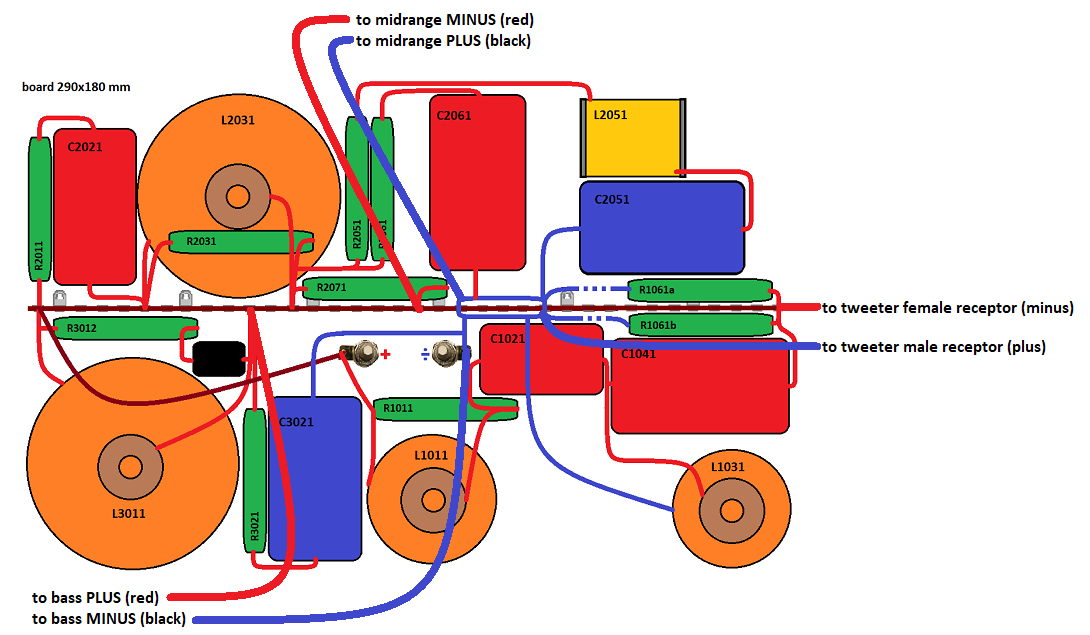
Example of Level 1 Crossover wiring.
Wiring is the same for all levels.
The dotted lines from tweeter attenuation resistors means that only one
of these resistors must be connected to ground.
JBL 4310
BACK
TO TOP
Go
to 4310 page
The LE20 tweeter is quite different from
the LE25 and LE26 tweeters, thus needs a different
crossover.
Performance of
new crossover
BACK
TO TOP
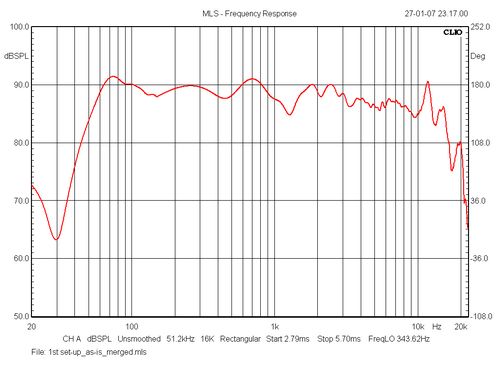
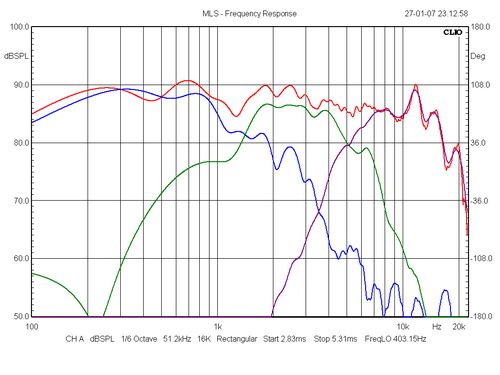
Left:
L100 frequency response from new crossover. The
dip at 1.3 kHz is caused by the small front
panel. Some of the LE25 tweeters display a peak
at 12 kHz. Some do not. However, I must say the
treble from the renovated L100 is remarkably
smooth. If your L25 tweeters are intact, do not
discard. They're excellent tweeters - only need a
proper crossover.
Right: Summed frequency
response, red, and response of individual drivers
from new crossover. All drivers now display
smooth roll-off characteristics.
|
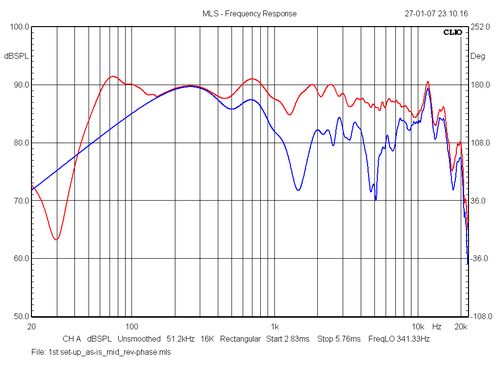 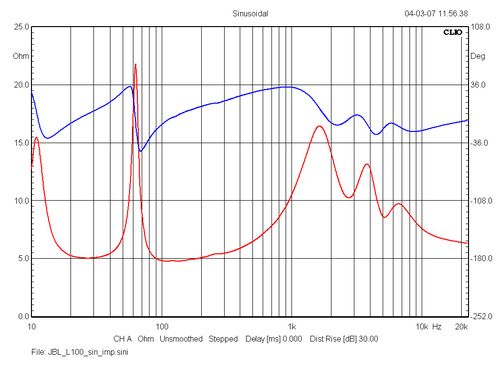
Left:The
litmus test: Reverse mid polarity. Reading taken
a 1 m distance at middriver height. Due to
placement of drivers, this reading may somewhat
depend on placement of microphone. In my own
recreation of the L100 I'll have a standard
vertical placement of drivers with mid and
tweeter slightly off-set.
Right: System impedance from
vented cabinet. This is an overall easy load on
our amplifiers. 5 ohms minimum impedance and the
negative phase angle at 70 Hz is where impedance
is high.
Final remarks to the L100:
I dare say it's
quite a different speaker compared to the
previous "two-caps" set-up. Classical
music is a delight, vocals are handled very well
and should you throw a Saturday evening party,
give it a 150 wpc amp and let it rock! It runs
well from my 20 wpc PSE valve amps, though not at
very high levels.
Thanks to Sven
for lending me his speakers for this up-grade.
It's been quite a journey and only thing
remaining is this: Should I make some radical new
cabs for my own drivers and what should it be?
The high-Qt bass driver might fit well into a TL
cab providing a smoother balance in the 50-100 Hz
range. This could be done without changing the
crossover at all. An approx. 80 liter TL
floor-stander, hmm....
One last thing:
The L100s need stands, at least 45 cm in height
to bring the 123A drivers off the floor.
Remember, the 123A is handling most of the
midrange and a 5 deg. tilt is doing even better.
I used the stands I made for the
L26-3W.
Final-final...
BACK
TO TOP
Some comments on L100
placement: The new crossover is tuned to
a placement like most modern speakers and due to
the high-Qt bass driver we already have some +3
dB in the 50-100 Hz range. If the first option
below is the only way you can place your
speakers, don't up-grade. We need the bass driver
up and out. From the new crossover, the 123A bass
driver still handles most of the midrange, thus
40 cm from floor level is not a good idea. I
recall studios using the 4311 and 4312
upside-down to get the 123A at ear-height.
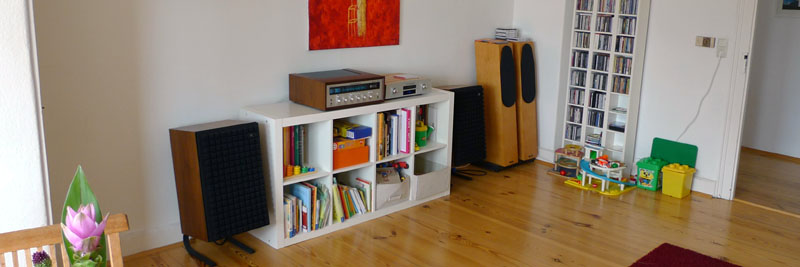
This is a no-no with regard to placement.
Too
close to the floor and front wall and too close
to the corner (for right speaker).
Based on simulation you will have +9 dB at 60-70
Hz. Way too boomy.
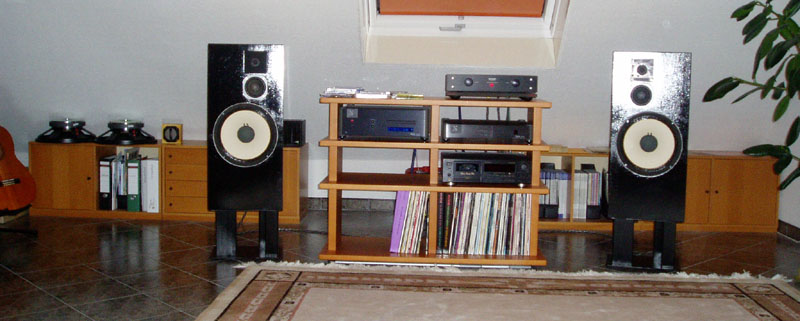
This German up-grader got it right: Free of
nearby boundaries and a much smoother response.
Enjoy!
|
Response from
people buying the up-grade kit
-
click heading to go to builders' response -
|
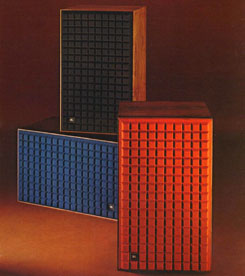


.jpg)





























